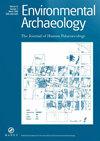Agricultural Dynamics in Southwestern Mediterranean France from the End of the Iron Age to the Early Middle Ages
IF 1.1
3区 地球科学
0 ARCHAEOLOGY
引用次数: 1
Abstract
ABSTRACTThe north-western Mediterranean rural world underwent major socioeconomic and cultural changes between the Late Iron Age and the beginning of the Middle Ages, with a decisive impact on the evolution of agricultural production, practices and landscapes. Roman expansion led to the spread of villae (2nd–1st c. BC), leading to a new structuration of rural areas and the development of a speculative agriculture that favoured wine production. By the end of the Roman period, new changes are observed: while certain Roman villae are still occupied, the appearance of a new network of rural settlements reveals the emergence of a new form of rural economy. Although these changes are increasingly well documented by archaeology, their impact on the agrarian production and practices remains little explored. The multiplication of archaeobotanical investigations in southwestern Mediterranean France allows us to present a first review of farming practices and their evolution during this key period. The study of 30 rural sites provides new data concerning local agriculture between the 2nd c. BC and the 8th c. AD (cultivated plants, prevalence of certain species, farming practices, exploited landscapes) and attempts to detect potential evolutions over time such as changes in staple crops, diversification, exploitation of new ‘terroirs’.KEYWORDS: Archaeobotanycropsfarming practicesfruit cultivationdiachronic approachsouthern France AcknowledgementsThis work was supported by the European Research Council (ERC) under the European Union’s Horizon 2020 research and innovation programme (grant agreement No. 852573). This research could not have been carried out without the work carried out over many years by various institutions, companies and colleagues working in Roussillon, in particular the Departmental Archaeological Service of Pyrénées-Orientales, Inrap, Acter, as well as the many archaeologists whose investment was essential to constitute the archaeobotanical corpus. We would also like to thank I. Figueiral (Inrap) for reviewing the quality of our written English.Disclosure StatementNo potential conflict of interest was reported by the author(s).Notes1 Website : https://www.try-db.org/TryWeb/Home.php2 Late Antique Little Ice Age.3 The status of Vicia lutea is hard to assess; its seeds have been found in great quantities mixed with Vicia sativa seeds. It might have been cultivated for fodder or be present in the sample as a (tolerated/favored?) weed of Vicia sativa.Additional informationFundingThis work was supported by European Research Council: [Grant Number 852573].Notes on contributorsRos JérômeRos Jérôme is a CNRS researcher (ISEM), archaeobotanist, and his work aims at documenting the evolution and dynamics of western Mediterranean agriculture and forestry, in relation to the social, economic and climatic changes that took place during historical periods.Angèle JeantyAngèle Jeanty is a PhD Candidate (ISEM), and her work focuses on the evolution of barley over the last 8 millennia in the north-western Mediterranean basin, using fine morphometric tools (traditional and geometric morphometry).Bouby LaurentBouby Laurent is a CNRS researcher (ISEM), archaeobotanist, and his work focuses on the history of agriculture and the exploitation of plant resources in the north-western Mediterranean, from the last hunter-gatherers to the end of the Roman period.Flora GarciaFlora Garcia is a former University of Montpellier Master student, working on the ecology of crop weeds within archaeobotanical assemblages.Kotarba JérômeKotarba Jérôme is an archaeologist (INRAP), specializing in the study of ancient and medieval archaeological sites in Mediterranean France.Passarrius OlivierPassarrius Olivier is an archaeologist (Service Archéologique du Département des Pyrénées-Orientales), specializing in the medieval archaeology and History of the Pyrénées-Orientales department.Puig CarolePuig Carole is a historian an archaeologist (ACTER archéologie), specializing in the history of rural and urban settlement in the medieval Pyrénées-Orientales department.Bénézet JérômeBénézet Jérôme is an archaeologist (Service Archéologique du Département des Pyrénées-Orientales), who works on Iron Age Roussillon (Pyrénées-Orientales department), particularly through its material culture.Guinaudeau NicolasGuinaudeau Nicolas is an archaeologist (ACTER archéologie), who is particularly interested in the medieval archaeology of southern France.Evin AllowenEvin Allowen is a CNRS research director (ISEM), bioarchaeologist, working on the biological and cultural history of domestic species and more particularly on the evolution of the relationship between human societies and domesticated plants and animals, using fine morphometric tools (traditional and geometric morphometry).铁器时代末期至中世纪早期法国地中海西南部的农业动态
从铁器时代晚期到中世纪初,地中海西北部的乡村世界经历了重大的社会经济和文化变化,对农业生产、实践和景观的演变产生了决定性的影响。罗马的扩张导致了村庄的传播(公元前2 -公元前1年),导致了农村地区的新结构和有利于葡萄酒生产的投机农业的发展。到罗马时期末期,出现了新的变化:虽然某些罗马村庄仍被占领,但新的农村聚落网络的出现揭示了一种新的农村经济形式的出现。尽管这些变化越来越多地被考古学所记载,但它们对农业生产和实践的影响仍很少被探索。在法国地中海西南部的考古植物学调查的增加使我们能够首次回顾农业实践及其在这一关键时期的演变。对30个农村遗址的研究提供了有关公元前2世纪至公元8世纪之间当地农业的新数据(栽培植物,某些物种的流行,耕作方法,开发景观),并试图检测随时间推移的潜在演变,如主要作物的变化,多样化,新“风土”的开发。本研究由欧洲研究委员会(ERC)在欧盟“地平线2020”研究与创新计划(资助协议号:852573)下支持。如果没有在鲁西永工作的各机构、公司和同事们多年来的工作,特别是东方pyrsamensimes - orientales、Inrap、Acter的考古部门,以及许多考古学家的投入,这项研究是不可能进行的,他们的投入对构成考古植物学文集至关重要。我们也要感谢I. figuiral (Inrap)审核我们的书面英语水平。披露声明作者未报告潜在的利益冲突。注1:网站:https://www.try-db.org/TryWeb/Home.php2古代性小冰河期晚期。它的种子被发现大量与紫豌豆的种子混合在一起。它可能是作为饲料种植的,也可能是作为一种(耐受的/受欢迎的?)豇豆(Vicia sativa)杂草存在于样本中。本研究由欧洲研究委员会资助:[资助号852573]。作者说明ros JérômeRos Jérôme是CNRS研究员(ISEM)、考古植物学家,他的工作旨在记录地中海西部农业和林业的演变和动态,以及历史时期发生的社会、经济和气候变化。jean: jean: jean: jean: jean: jean: jean: jean: jean: jean: jean: jean: jean: jean: jean: jean: jean: jean: jean: jean: jean: jean: jean: jean: jean: jean: jean: jean: jean: jean: jean: jean: jean: jean: jean: jean: jean:Bouby LaurentBouby Laurent是法国国家科学研究中心(ISEM)研究员、考古植物学家,他的研究重点是地中海西北部的农业历史和植物资源的开发,从最后的狩猎采集者到罗马时期末期。弗洛拉·加西亚(Flora Garcia)是蒙彼利埃大学(University of Montpellier)的前硕士研究生,从事考古植物组合中作物杂草的生态学研究。Kotarba JérômeKotarba Jérôme是一位考古学家(INRAP),专门研究法国地中海地区的古代和中世纪考古遗址。Passarrius OlivierPassarrius Olivier是一名考古学家(Service archsamologique du dsampartement des pyrsamncim - orientales),专门研究pyrsamncim - orientales部门的中世纪考古学和历史。普伊格·卡罗尔是一位历史学家和考古学家(ACTER archsamologie),专门研究中世纪pyr - orientales部门的农村和城市定居点的历史。bsamnsamzet JérômeBénézet Jérôme是一位考古学家(Service archsamologique du dsampartement des pyrsamncim - orientales),他研究铁器时代的鲁西隆(pyrsamncim - orientales department),特别是通过它的物质文化。吉纳多·尼古拉斯吉纳多·尼古拉斯是一位考古学家(ACTER archologie),他对法国南部的中世纪考古特别感兴趣。Evin Allowen是CNRS的研究主任(ISEM),生物考古学家,致力于家养物种的生物和文化历史,特别是人类社会与家养植物和动物之间关系的演变,使用精细的形态测量工具(传统和几何形态测量)。
本文章由计算机程序翻译,如有差异,请以英文原文为准。
求助全文
约1分钟内获得全文
求助全文
来源期刊

Environmental Archaeology
GEOSCIENCES, MULTIDISCIPLINARY-
CiteScore
4.80
自引率
0.00%
发文量
32
期刊介绍:
Environmental Archaeology: The Journal of Human Palaeoecology aims to publish contributions on all aspects of environmental archaeology, from methodology to synthesis and theory.
Environmental Archaeology is an international peer-reviewed periodical which welcomes contributions that consider the interaction between humans and their environment in the archaeological and historical past. This broad scope embraces papers covering a range of environmental specialisms within archaeology, such as archaeobotany, archaeozoology (both vertebrate and invertebrate), palynology, geoarchaeology, biological anthropology, as well as more synthetic and theoretical approaches to the past human environment. Assemblage and site reports are not encouraged unless these can demonstrate significant new insights in environmental archaeology. Contributions may take the form of substantial research papers or shorter reports and may include, for instance, new techniques, philosophical discussions, current controversies and suggestions for new research. The journal also provides its readership with critical appraisal of recent academic scholarship through its regular books review section.
 求助内容:
求助内容: 应助结果提醒方式:
应助结果提醒方式:


